On the Road is a weekday feature spotlighting reader photo submissions.
From the exotic to the familiar, whether you’re traveling or in your own backyard, we would love to see the world through your eyes.
randy khan
Today’s going to be all glass, and actually all one piece of glass. On our second day in Venice, we watched a demonstration by Davide Salvadore and his team. Glassblowing almost always is a team effort, and everyone has a part. The studio was pretty small, our group was incredibly close – close enough to feel the heat – and my wife and I were in the front row.
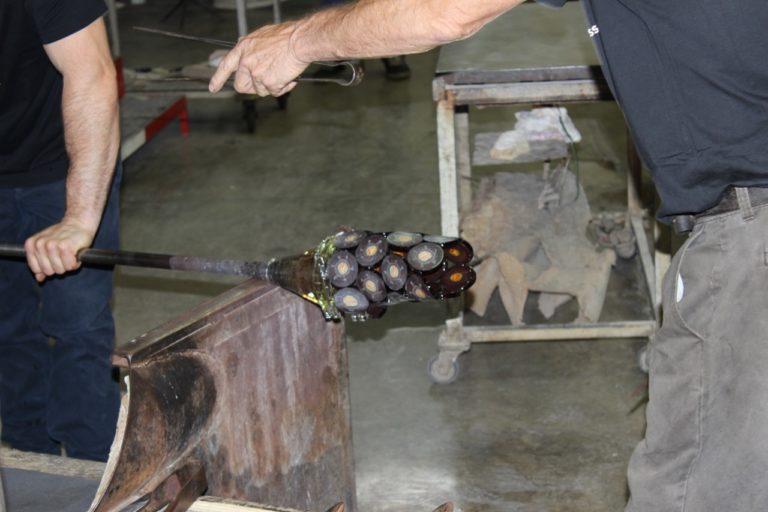
This sequence picks up after the preliminary parts were done. The first thing they did was dip the pipe you see here into a furnace that was filled with molten clear glass to pick up the glass on the pipe in what’s called a gather. They blew a bubble through the pipe, shaped the glass into cylinder, and cooled it somewhat. (You can tell how hot glass is by the color – bright orange is really hot, and it gets closer to its real color as it cools.) Meanwhile, the little disks you see were laid out on a metal table and heated with a blow torch, because cold glass touching hot glass is a recipe for disaster. When the gather was shaped properly and cool enough, and the disks were hot enough, Salvadore rolled the cylinder on top of the disks, and they stuck to the cylinder.
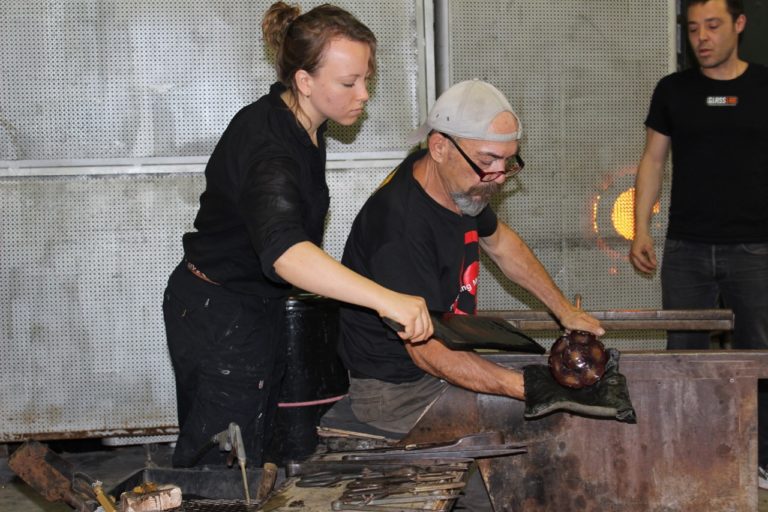
The next step was smoothing the disks onto the bubble. That thing he’s holding in his hand is, I think, some kind of silicon pad soaked in water. (Traditionally, and most commonly, this is done with a thick wad of wet newspaper. Really.) The water turns to steam and between the steam and the pad itself forms a shield that keeps the glass from burning all the skin off his hand. He puts pressure on the glass through the pad to shape the glass. It’s kind of unbelievable, but it works.
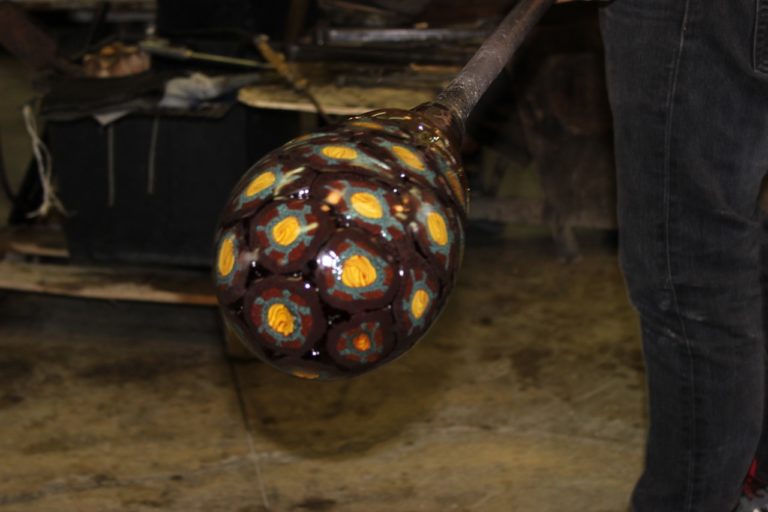
Here’s the piece after the disks were fully incorporated into it.
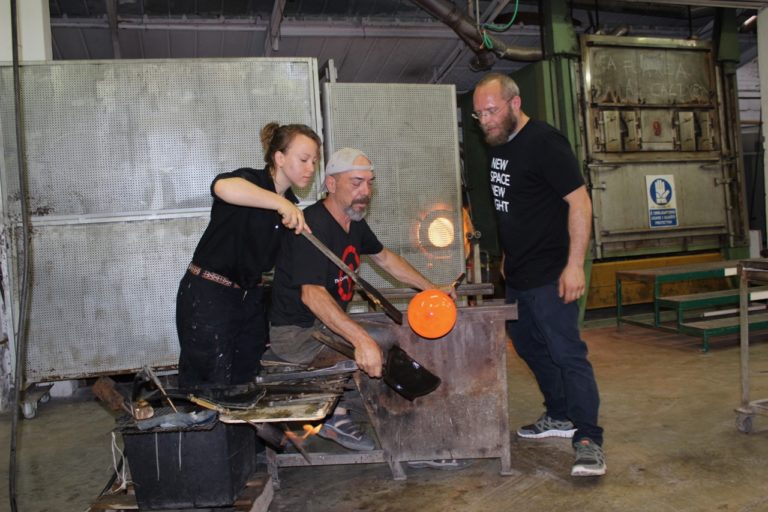
They added another layer of glass on top of the disks. He’s using what’s called a block to shape it now. Blocks usually are made from cherry or some other very dense wood and like the newspaper they’re soaked in water. (Usually they sit in a buck filled with water unless they’re in use.) Blocks eventually get burned out, but it takes a while.
This piece was a platter, and as you can tell, the end you can see is solid. So the next problem is how to get the solid part at the back and the open part (where the air was blown to create a bubble at the front.
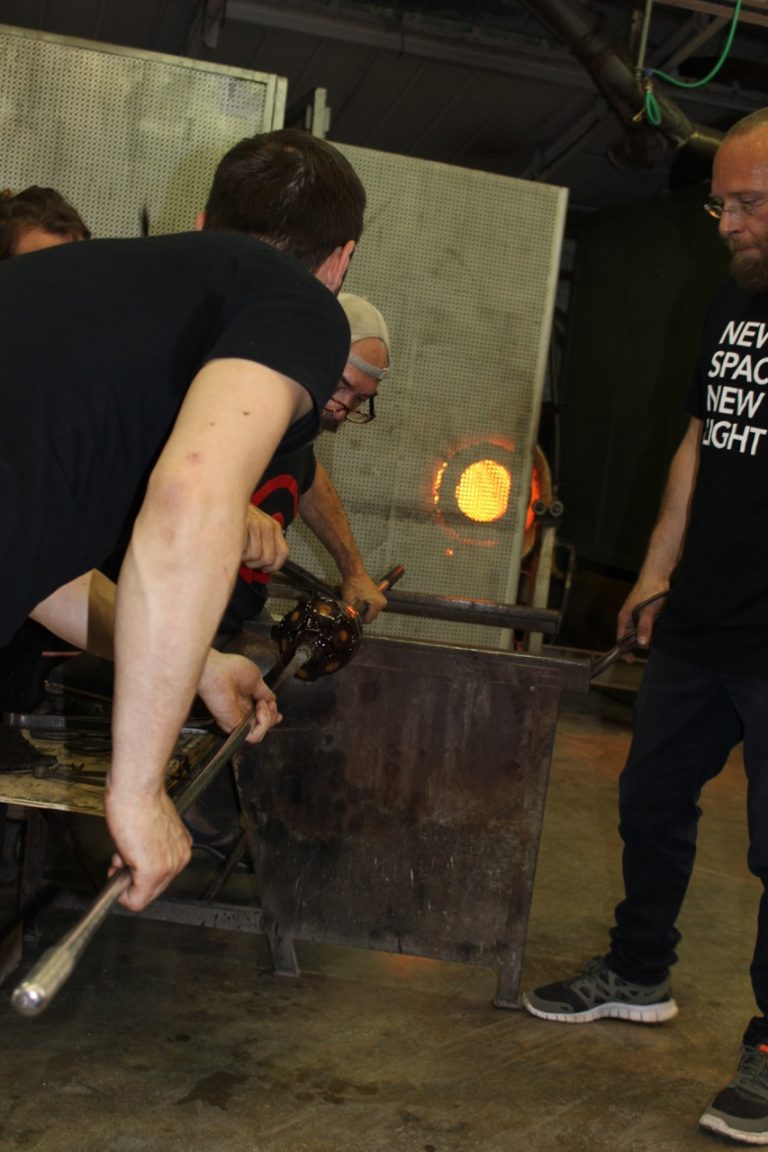
This is how you do that – you attach another pipe (called a punty) to the solid part. You start by putting a bit of glass on the punty and creating a cylinder. Then, once again, you have to match the temperature of the punty and the main piece so you can connect them without breaking either part. But the end where the punty is connected has to be hotter than the other end, because you do want to break that part off the blowpipe. When you’re ready, you connect the punty to the piece, put a drop of water on the place you want to break off, tap it lightly, and pray that it breaks the way you want. Pros can do it 99 times out of 100.
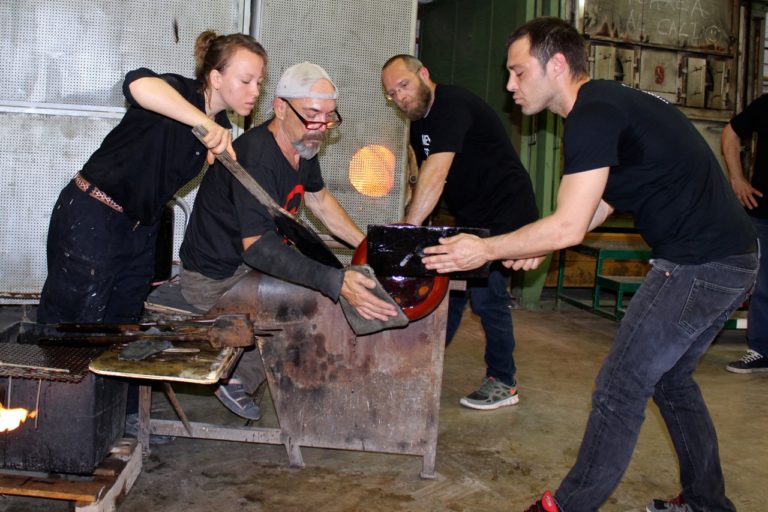
Now it’s time to turn it into a platter. There are two things that had to happen – the edge that was broken off had to be smoothed out and the opening needed to be spread out to platter shape. This is my favorite photo of the bunch because it involves the whole team. Salvadore is in the middle, shaping the side with the pad. The guy in back is turning the pipe to make sure the piece keeps its shape. (The glass is semi-molten the whole time.) The guy on the right is using the wood paddle to keep the rim smooth and even. And the woman is using her wood paddle to keep Salvadore from getting burned. It’s an intimate ballet, and everyone knows exactly where to be at all times. Salvadore barely said a word or made a gesture while he was making the piece.
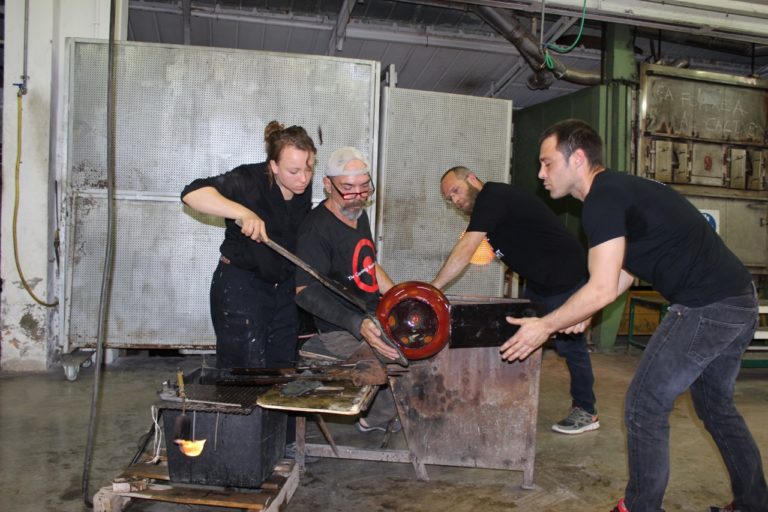
Here the platter was almost ready for the final step. You can see that they have opened up the hole quite a bit, but right now it still looks like a bowl, so it’s not there yet.
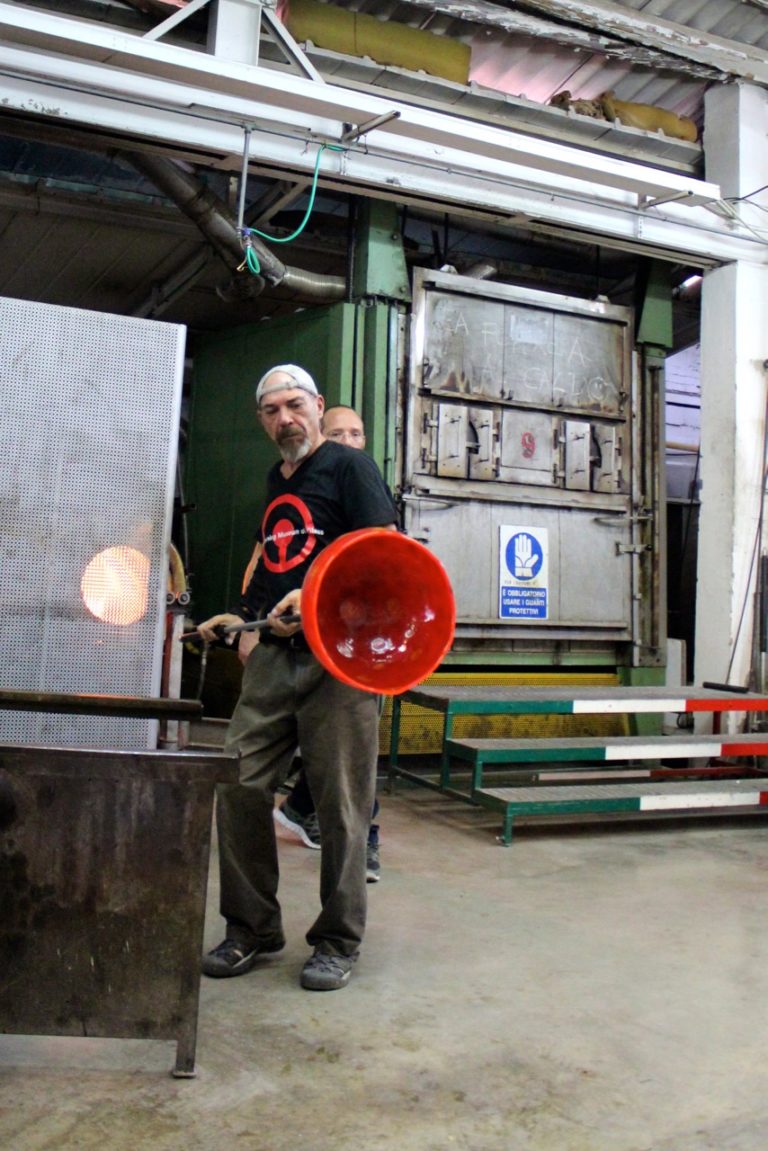
This whole process took about 45 minutes from start to finish. The glass wouldn’t stay hot enough nearly that long, so they constantly take it from the bench and put it in a furnace (in the U.S., it’s often called, uh, a glory hole, but officially it’s a reheating oven, and people are starting to move away from the other term) to get it hot enough again. It needed to be pretty hot at this point because it had to be pretty soft.
This is the final step in making the platter: He’s spinning the pipe and centrifugal force is pushing the rim of the platter out and flattening it. This is really dramatic to watch when it happens, even if you’ve seen it twenty times before.
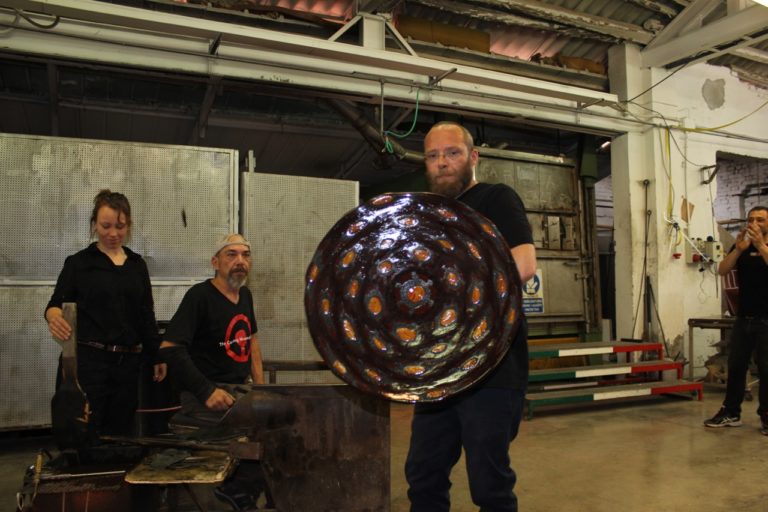
And here’s the final platter, spun out and flat. Although it’s still pretty hot, it’s cooled down enough to be solid, and it’s ready to be broken off the pipe. Once it’s off the pipe, they put it an oven for annealing, which is bringing the temperature down slowly so the glass doesn’t crack. It probably took about a day, but it can take a lot more time for big and heavy pieces. Some big pieces of cast glass can take months to anneal.
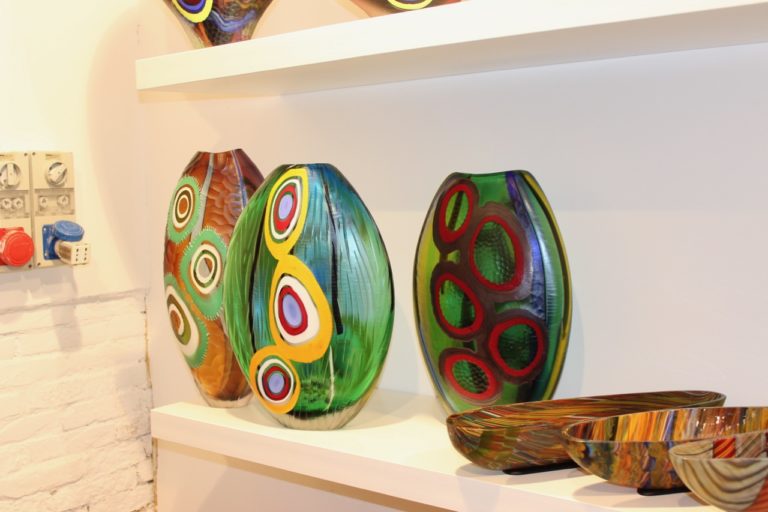
Finally, here is some more work from the studio. I thought it would be nice to see the actual colors, rather than the colors distorted by heat.

Lapassionara
Oh my, what an amazing process! And your photographs are outstanding. Thank you.
arrieve
This is fascinating. If I ever go back to Venice…..
Just Some Fuckhead
We watched the second season of Blown Away on Sunday. Really a delightful competition show.
Mary G
Excellent demonstration and explanation. Another new item for my bucket list. Love that the old crafts are being preserved, even with new tools like the silicon pad standing in for newsprint.
Fair Economist
I love glass art. Reluctant to get more now because I live in California in a house with tile floor. But I am really loving this series.
randy khan
@Fair Economist:
Two words: Museum wax (or museum gel, take your pick).
True story: The biggest earthquake to hit D.C. in more than a century happened about 9-1/2 years ago (magnitude 5.8, centered about 90 miles away). Every piece that had museum gel on the base stayed put. The ones we’d forgotten to stick down moved (although nothing broke, which was very lucky). The stuff works.
Auntie Anne
Amazing . . . Just incredible pictures and descriptions of the process. Thank you, thank you, thank you.
Wag
holy mackerel. That is totally cool. We went to Marano when we were in Venice 15 1/2 years ago, but didn’t get a chance to tour the glass foundries. Amazing!
Dan B
Tacoma, WA has the Museum of Glass, and some other fine museums of history and art. They blow glass all the time in a glass studio in the museum. Also the Pilchuck Studio used to have open days. It’s where Chihuly and many others got their start. And there’s the Chihuly garden (? – haven’t been yet) in Seattle. Looks over the top but that’s Chihuly. So if you can’t get all the way to Murano it’s an alternate, complete with lots of water.
One big prize is to get a tour of Chibuly’s houseboat on Lake Union on the north side of downtown Seattle. There’s a swimming pool on the houseboat full of Chihuly glass – on the bottom.
Paul W.
My partner and I loved Blown Away and are watching the second season as I write this. Loving the step by step descriptions so I have a little more insight into the magic.
Mart
Glory hole, sheesh. Still work with a lot of plumbers with male and female fittings, but it’s getting better.
randy khan
@Dan B:
Yeah, touring the Chihuly studio is something. But if you can’t get there (and even if you can), the Chihuly Gardens and Glass is worth a visit. Personally, I think outdoors in a garden is the natural habitat of his work.
LongHairedWeirdo
@Just Some Fuckhead: I was going to call that show out in comments, but I was betting someone else already had. It’s a fascinating show, if only for the wide variety of amazing things people do with glass.
JanieM
Great pictures and fascinating explanations.
It’s amazing to imagine how many steps and missteps it took over the centuries for people to figure out how to do these things. Also amazing to see a team of people not only working together this way, but doing it in front of an audience. I guess if sports teams can do it, other kinds of teams can, but the level of concentration is impressive either way.
Sourmash
Fun fact: Venice got rich from, among other things, Murano glass beads, which were made in their… millions, maybe. These were anywhere from miniscule pieces of 1/8 of an inch or less, up to an inch or more long and were highly valued by the Native Americans in North America and sub-Saharan Africans for their decorative value. The brightly colored beads on highly decorated headdresses, moccasins, clothing, etc. are often from Venice. Just a reminder that the tentacles of colonialism and old time international trade show up in the oddest places.
Palindrome
Wow! My daughters brought me some goblets back from Murano many years ago but I had no idea what it took to make them. Thank you for the post.
Albatrossity
Wow, what a great sequence of photos, and a fabulous story. Much appreciated!
MelissaM
Came here to mention Blown Away, see I’m number 4 or 5. The personalities can be annoying, but I’m still fascinating watching the glass blowing process. Such a cool art!
SkyBluePink
Wonderful pics and descriptions!
Shana
Fabulous! Thanks for all the great pictures and descriptions. You mentioned yesterday about the little places on the 2nd floors from your tour. Can you pass along any names and addresses? Thanks.
J R in WV
Just a few miles away from our farm is Blenko glass, an old fashioned art glass manufacturer using the same techniques used in this post.
They supply antique style glass to places like Williamsburg, the White House, etc, as well as doing art glass of all kinds.
randy khan
@Shana:
I’m sure they all had addresses, but we were being led around so I have no idea what they were. I might or might not be able to find any of them again if I were dropped on Murano. I’m trying to mention names as I go along, so you might be able to look them up if you go to Murano. Cesare Toffolo’s place (mentioned yesterday) was definitely a showroom, probably open by appointment (and based on his website it’s somewhere along the narrower of the two main canals on Murano), and Davide Salvadore had what was more or less a small retail space in the front of his studio, which is where I took the last photo in this set.
randy khan
@J R in WV:
We haven’t made it to Blenko, but we really need to get there.
Shana
@randy khan: Thanks.